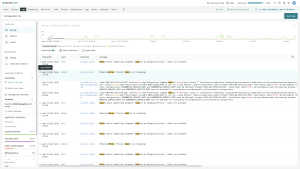Efficient log management is crucial for organizations to achieve observability, troubleshoot issues effectively, and maintain optimal system performance. As software systems continue to grow in complexity, scaling logging on a budget becomes a significant challenge. But with the right strategies, it’s possible to achieve cost-effective log management without compromising on quality.
This blog post explores valuable tips and techniques to help you scale logging on a budget, optimize your log management processes, and drive value for your organization with the help of New Relic:
- Selecting the right logging solution
- Avoiding common mistakes when selecting a logging solution
- Implementing tips for effective log management to scale logging on a budget
- Centralizing your log management
- Implementing log rotation and retention policies
- Optimizing log collection
Choosing the right logging solution
When choosing a logging solution, you have many options, including open source logging tools and commercial products. It’s crucial to evaluate your options based on your organization's needs, resources, and budget to determine the best solution.
Factors to consider when selecting a logging solution include scalability, reliability, ease of use, security, and cost. Scalability refers to your logging solution's ability to handle an increasing volume of logs as your organization grows. Reliability entails ensuring the logging solution provides uptime guarantees and meets the organization's service-level agreements. Ease of use is critical for integration with existing workflows and team adoption.
Security is essential for protecting logs and the organization's data, so choose a solution with robust security measures. For example, you can obfuscate critical data in logs to protect your user’s personally identifiable information (PII) and reduce the risk of storing that information.
Finally, cost determines the budget allocated for logging and the available features in the chosen solution.
Avoid these common mistakes
To ensure your organization benefits from efficient log management without unnecessary expenses, you’ll need to avoid these common mistakes when selecting a logging solution. Some common pitfalls include:
- Overbuying: Purchasing a solution with more features than necessary can lead to increased costs without providing additional value. Evaluate your organization's logging requirements carefully to choose a solution that meets your needs without excess features.
- Underbuying: Opting for a solution that does not meet the organization's needs can result in inadequate logging capabilities, making it difficult to monitor and troubleshoot issues. Carefully assess your requirements to ensure the chosen solution provides the necessary features and scalability for your organization's growth.
- Vendor lock-in: Choosing a solution that is difficult to migrate from can limit your organization's flexibility and make it challenging to switch providers if your needs change. For easy integration with other systems, New Relic allows for seamless migration if needed with almost 600 quickstart integrations, and also supports OpenTelemetry.
- Falling into pricing or billing traps: Some vendors employ confusing pricing models or include hidden fees, making it difficult to estimate the total overall costs. Understanding these traps can help you make an informed decision when selecting a logging solution.
Factors that impact your logging costs
When managing and optimizing logging costs, it's important to understand the various factors that contribute to these expenses. Here are some key elements to consider:
Volume of log data: The amount, complexity, and frequency of log data generation significantly affect costs. Systems with high traffic or verbose logging produce more data, leading to higher costs.
Retention period: Longer retention periods for logs require more storage space, which increases costs. The duration for which logs are stored plays a crucial role in determining overall expenses.
Detail and format of logs: The level of detail and the format in which logs are maintained can impact storage and processing needs. Detailed logs take up more space and require more processing power, contributing to higher costs.
Log management tools and services: The choice of tools and services for log management can vary in cost efficiency. Some offer better data compression or more economical storage options, affecting overall costs.
Advanced features: The need for advanced log management features like real-time analysis, search capabilities, and system integration can also increase costs. These features, while beneficial, can add to the complexity and expense of log management systems.
Best practices for cost-effective log managementt
To scale logging on a budget, adopt these best practices for log management:
1. Manage your logs from a centralized location
Implement a centralized log management system, such as New Relic, that aggregates logs from various sources like applications, servers, network devices, and other infrastructure components. This centralization allows for easier and more efficient analysis, monitoring, and troubleshooting of logs, providing better visibility into system performance, security, and other operational aspects without context switching between tools.
2. Implement log rotation and retention policies
Determining how long to keep and store logs is a challenge, but it also requires understanding the log lifecycle. For more details, see how to manage an application log.
- Archive and delete old logs: Storage and processing costs increase with log volume. Log rotation is essential for cost-effective log management because it helps efficiently manage storage usage and control costs by periodically archiving or deleting old logs, ensuring that only relevant data is retained. It's important to note that log rotation is a strategy best suited for on-premises storage.
- Retain what’s necessary for only as long as you need: Log retention policies are crucial for cost-effective log management because they define how long logs should be kept, ensuring storage is used efficiently by retaining only the necessary data. This approach not only helps control storage costs but also assists in meeting compliance requirements and simplifying data analysis. For operational purposes, 30 days is more than long enough to store your logs, though some companies and industries might require 90 days or more for compliance purposes.
- Review and update policies consistently: Regularly reviewing and updating log rotation and retention policies ensures that they continue to align with the organization's evolving requirements, compliance obligations, and storage limitations. By adapting to changes in the system or regulatory landscape, you can maintain cost-efficient log management while preserving necessary data and minimizing storage overhead.
3. Optimize how you collect logs
Optimizing the collection of logs is essential for efficiently managing and analyzing large volumes of log data.
- Identify essential logs: Determine which logs are crucial for monitoring application performance, security, and compliance. Focus on collecting logs that provide meaningful insights and actionable information.
- Implement drop filter rules and aggregate logs: Implement log drop filters in New Relic, so only relevant logs are collected and forwarded. Aggregate similar logs to reduce the volume of data while still capturing vital information, using New Relic to create metric data.
- Use structured logging: Implement structured logging to create logs with consistent, machine-readable formats, making it easier to process, analyze, and store the logs efficiently.
- Implement log sampling: Employ log sampling to collect a representative subset of logs, reducing the volume of logs collected while still providing valuable insights.
- Enrich your logs with metadata: Enrich logs with additional metadata, such as application, environment, or user information, to provide more context and facilitate easier analysis and troubleshooting.
- Monitor log collection in real-time: Continuously monitor log collection to identify issues, bottlenecks, or inefficiencies. This allows for rapid adjustments and improvements to the log collection process.
- Automate log collection and management: Employ automation tools and techniques to streamline log collection, reducing manual intervention and ensuring consistent, efficient log management.
- Evaluate and adjust periodically: Regularly review and update your log collection strategy based on changing business requirements, application updates, or compliance needs. This ensures that your log collection process remains efficient and cost-effective.
4. Monitor and analyze logs in real-time
Quick identification and response to issues is only possible with proper monitoring and analyzation in real time.
- Leverage an observability platform like New Relic to gain insights into application performance, infrastructure health, and log analytics to address issues in real-time to reduce mean time to resolution (MTTR) and mean time to detection (MTTD).
- Use log data to identify and prioritize issues, optimize log collection, and reduce overall log volume.
- Proactively address potential issues to prevent expensive downtime, security breaches, or performance degradation.
- In addition to being able to see, sort through, and use the log info you forward to New Relic, you can also use logs combined with other tools to get a broad picture of what is going on over your entire system.
5. Log meaningful messages
Effective log messages should be detailed enough for teams to be able to understand, diagnose and determine why an error or event happened so they can take necessary action. For example, a Transaction Failed error message doesn’t reveal much. Instead, opt for a Transaction Failed: Could not create user ${path/to/file:line-number}.
6. Use a parsable log format
New Relic log management makes it easy to define custom log parsing rules, but parsing rules can’t work their magic if log data is unintelligible. A parsable format means that log entries are structured in a way that makes it easy for software tools to extract relevant information.
One common and widely used parsable log format is JSON (JavaScript Object Notation). JSON is a lightweight data interchange format that is easy for humans to read and write, and easy for machines to parse and generate. Here's an example of a log entry in JSON format:
{"timestamp": "2023-01-10T12:34:56.789Z",
"level": "INFO",
"logger": "application",
"message": "User login successful",
"user": {
"id": 123,
"username": "john_doe"
},
"ip_address": "192.168.1.100",
"application_version": "1.2.3",
"duration_ms": 150}
In this example:
- "timestamp" represents the time when the event occurred.
- "level" indicates the severity level of the log entry (e.g., INFO).
- "logger" specifies the source or component that generated the log entry.
- "message" contains a descriptive message about the event.
- "user" is an object containing information about the user, such as their ID and username.
- "ip_address" holds the IP address associated with the event.
- "application_version" indicates the version of the application.
- "duration_ms" represents the duration of the event in milliseconds.
This JSON structure allows for easy parsing and extraction of specific information. Tools and scripts can process these log entries, and each field has a clear, predefined meaning. Additionally, because JSON is human-readable, developers and system administrators can review log entries directly.
Common questions and concerns about effective logging on a budget
Let’s tackle some frequently asked questions about scaling logging on a budget, and how New Relic can help.
How can I reduce log storage costs?
Using New Relic log management, you can optimize log collection by configuring drop filter rules to exclude irrelevant logs before they're ingested. By collecting only essential logs, you can reduce storage costs.
Learn more: New Relic log mangement and Drop filter rules
How can I ensure my logging solution is reliable and secure?
New Relic offers a secure and reliable platform, compliant with industry-standard security measures. It provides encryption in transit, ensuring that your log data is securely transmitted. Combining your log data with the data from New Relic infrastructure and synthetic monitoring, you can detect potential security risks and use that log data to prevent risks moving forward. To ensure data privacy and follow your organization’s log security guidelines, the New Relic log management service includes the ability to obfuscate PII, access tokens, and any other private or regulated data.
Learn more: New Relic security and Control data privacy with New Relic log obfuscation options
What are best practices for log retention and rotation?
New Relic offers configurable log retention settings, allowing you to store logs for a duration that aligns with your organization's requirements. While New Relic doesn't directly manage log rotation, you can configure it to work with your existing log rotation solutions.
Learn more: Manage data retention
How can I efficiently manage log rotation?
You can use external tools and processes to handle log rotation and integrate them with your New Relic setup. By centralizing log management with New Relic, you can monitor and analyze logs across various sources, simplifying the management of log rotation.
Learn more: Log forwarding
How can I reduce log storage costs while maintaining observability?
To reduce log storage costs without sacrificing observability, leverage New Relic log management for optimizing log collection, dropping irrelevant logs, and analyzing essential logs more effectively. Use New Relic querying and visualization features to gain insights into application performance, infrastructure health, and log analytics. This approach helps you maintain adequate levels of observability while reducing storage costs.
Learn more: New Relic log management
Conclusion
Scaling logging on a budget requires implementing effective logging bestt practices. By centralizing log management, implementing log rotation and retention policies, optimizing log collection, and leveraging structured logging, you can reduce unnecessary expenses while maximizing value. Real-time log monitoring and analysis, along with automation, streamline processes and improve efficiency. Regular evaluation and adjustment of log management strategies ensure adaptability to changing business needs.
By following these tips and using tools like New Relic, you can achieve cost-effective log management, gain valuable insights, improve troubleshooting capabilities, and optimize system performance without breaking the budget. With the right approach, scaling logging on a budget becomes an achievable goal, empowering organizations to achieve observability and operational excellence.
다음 단계
- Are you eager to learn more about optimizing log management costs? Discover detailed strategies and best practices by downloading our comprehensive eBook How to Optimize Log Management Costs. Gain valuable insights and unlock the secrets to cost-effective logging with New Relic today.
- Learn how to shift to effective logging for full-stack observability with Log Management Best Practices.
- Learn how teams at Virtuo, a fast-growing car rental startup, transformed their logging practices and achieved improved performance and observability with New Relic. Read the customer story to discover their success and see how your organization can benefit from similar results.
- Ready to optimize your log management and save on costs? Experience the benefits of a powerful logging solution with New Relic. Sign up today for a free New Relic account and gain insights into your application performance, infrastructure health, and logs.
- Got lots of logs? Check out our tutorial on how to optimize and manage them.
- For more information on logging, see our logging best practices guide.
이 블로그에 표현된 견해는 저자의 견해이며 반드시 New Relic의 견해를 반영하는 것은 아닙니다. 저자가 제공하는 모든 솔루션은 환경에 따라 다르며 New Relic에서 제공하는 상용 솔루션이나 지원의 일부가 아닙니다. 이 블로그 게시물과 관련된 질문 및 지원이 필요한 경우 Explorers Hub(discuss.newrelic.com)에서만 참여하십시오. 이 블로그에는 타사 사이트의 콘텐츠에 대한 링크가 포함될 수 있습니다. 이러한 링크를 제공함으로써 New Relic은 해당 사이트에서 사용할 수 있는 정보, 보기 또는 제품을 채택, 보증, 승인 또는 보증하지 않습니다.



